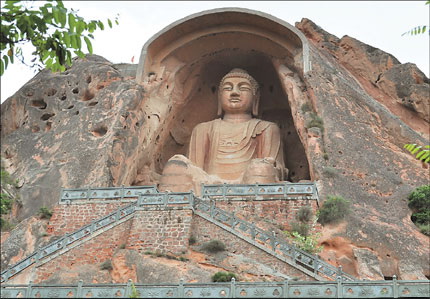Journey to the wild, wild West
 |
|
The most celebrated place of interest on Mt Xumi in Guyuan City is the Giant Sitting Buddha Maitreya in Grotto No. 2, measuring 26 meters in height.[Photo/Xinhua] |
Drawn by the romance of the far west, Liu Qi ventures into the vast desert in Ningxia where she makes friends with a camel before heading south on other adventures near the Silk Road.
Stretches and stretches of sand dunes extending as far as eye can see, a train of camels trudging against the skyline, turbaned trekkers braving the searing heat and dust ... I was so haunted by this vision that I realized it was time to go west.
I flipped a coin and decided on the Ningxia Hui Autonomous Region, land of the little-explored Western Xia State (1038-1227), exotic Chinese Muslim culture, and of course, the desert where kingdoms rose and fell and ruins are buried.
The minute I stepped out of the Yinchuan airport (a two-and-a-half-hour flight from Shanghai), I found a somewhat cliched capital city: well-constructed roads and modern buildings. My disappointment at the mundane, however, was soon be replaced by pleasure with the novelty of back streets navigated by my taxi driver.
The various mosques, the unique dress of the Hui minority people, the all-pervasive small of mutton - all reminded me that I had stepped out of my Shanghai routines and was right in the middle of my dream of the wild, wild west.
Ningxia is a raw landscape of stark mountains and dusty plains sliced in two by the Yellow River. This was clear when I traversed the Yellow River on a sheep-skin raft. The sparse and boring industrial landscape gave way to fascinating mountains cape that suddenly emerged from nowhere. I passed flocks of sheep at the foot of a severely weathered section of the Great Wall as I traveled toward the edge of the 42,000-square-kilometer Tengger Desert, China's fourth-largest desert.
To get there, I traveled 150km from Yinchuan to Zhongwei City near the sands.
Unlike some of the arid places I've been to, the Tengger is classic desert: The endless waves of sand dunes stunned me as soon as I entered the Tonghu side of it.
This was where my desert daze began: For a whole day, I shrieked my guts out as I was catapulted up and down and tossed back and forth on daredevil jeep rides on sand dunes that seemed to transform and shift by the minute. I climbed up the sand dunes (barefooted for a while), hung out on their highest ridge, dug my toes into the sand and then slid back down the slope on my bottom.
I was lucky because the sun was not a big enemy in this season (the temperatures in May and June are very tolerable), but I still constantly fought persistent sandstorms that seemed to accompany my every step and sometimes sent sand lashing painfully against my cheeks.
This was my first "sand experience" and I was so excited that I took off my shoes and let the feet reach deep into the fine yellowish sands, feeling it and touching it.
At first the desert might seem devoid of life - just sand, sand, sand and nothing else - but here and there were hardy green plants, withered wood and insects that added color. I was lucky to spot an owl that probably preyed on rodents (hidden in holes during the day) and large beetles and desert cicadas that run around on the dunes.
Before this transformative trip, there were two animals I had no affection for or interest in whatsoever - camels and horses. I told myself from the beginning that I would not get close to a camel, let alone sit on one.
But I soon broke my vow about avoiding nasty camels after I saw them sitting quietly and peacefully in the sands. As I approached, they greeted me with a friendly nod.
At that moment I decided I'd like to take my maiden camel ride. My camel was cute, clean and very obedient. I patted him and he replied with a "grin."
When the guide and I tried to ascend a particularly tricky high dune, a strong wind gust blinded me for a moment (my camel with double rows of extra-long thick lashes was okay), I got nervous. The camels were tackling the dune and I was fighting the sand in my eyes while tightly gripping the rocking saddle. When the blow was over, we shared a sand-filled, slightly worried laugh about the adventure that I won't forget for a long time.
In the process of my camel encounter, I finally reconciled with the peculiar but admirable creature that never complained and was so perfectly suited for the environment so harsh on man and beast - a true desert hovercraft and indeed, a quite endearing creature.
I kept my vow about horses and steered clear.
Since the narrowest part of the Tengger is only a little over 20km, it's possible to hike across the sands.
It takes around six hours on camelback to get to the other side of Shapotou, a highly touristy place, from Tonghu, which is somewhat less commercial. A walk takes eight to 10 hours. When the weather is nice, you can appreciate the gorgeous desert sunset and many fantastic desert landscapes.
If you're adventurous enough or want more fun, take a detour into the desert - riding a camel across all those rolling dunes, the desert is all yours, no traffic jam.
Although Tonghu resort provides accommodation, camping outside on the sand dunes in the Tengger is a fun alternative. It's pretty safe to camp on the desert near the resort; there are no wild animals and seldom a dangerous sandstorm.
This is right on the border with the Inner Mongolia Autonomous Region, so at night, you can join guests from everywhere inside a yurt for a typical Mongolian dinner party. Singing, drinking, and Mongolian barbecue are basic. Definitely ask locals to sing Mongolian folk songs from their hometowns, all of them are great singers.
Go south
To get a real taste of Ningxia, the awesome desert tour is only part of the adventure. Leaving behind the modern Yinchuan, I headed deep south to Guyuan, which is famous for mountains, grottoes, gorges and Danxia landforms.
My first stop in Guyuan, one-hour flight from Yinchuan, was Xumi Grottoes at the eastern foot of Mt Xumi, 55km northwest of the city.
This is a gateway on the ancient Silk Road and part of the magnificent Liupan Mountains. The grotto carving began in the late Northern Wei Kingdom (AD 386-534).
Twenty-two grottoes are well preserved, with a rich collection of high-quality carvings of the Northern Wei, the Northern Zhou (AD 557-551), the Sui (AD 581-518) and the Tang (AD 618-907) dynasties.
This area used to be a key passage on the Silk Road between the East and the West and a thoroughfare for exchanges between the Han Chinese and minority ethnic groups.
The most celebrated place of interest in the mountain is the Giant Sitting Buddha Maitreya in Grotto No. 2. The Maitreya measures 26 meters high, with its ears the length of two adults put together. The Buddha with a benign look is considered a representative masterpiece of the grotto on the mountain.
Grotto No. 5 is the biggest of its kind. Made of a hollowed-out mound, it is called the "Haloes of Xumi" and contains seven well-preserved Buddhist statues, each 6 meters in height, and seven Bodhisattva statues. These figures look mysterious and fascinating under a few rays of light that enter the grotto through a hold in the roof of the mound.
Due to devastation by earthquakes and windstorms in its 1,400-year history, half of the grotto was caved-in, but it has recently been restored.
Another an hour from the grottoes, I reached my last but arguably the most impressive stop in the south - Yanzhi Canyon. In Chinese, yanzhi means rouge, and legend has it that a fairy came down from heaven one day and washed her faced in the Huanghua River (running through the canyon). And then rouge on her face dyed the river red.
The canyon neighbors Mt Kongdong to the east, Mt Liupan on the west and Old Dragon Pool on the south. Formed in the Ordovician Period of about 800 million years ago, it was named after the minority Yanzhi Clan of the Spring and Autumn Period (770-476 BC). The clan evolved from the Yanzhi Tribe, and then lived near the canyon during that period.
The river runs joyously through the steep canyon and transforms into waterfalls in various sizes and forms. Everywhere in the central area of the canyon, you can see strangely shaped pines and weird rock formations, flowers and rare vegetation.
There are several views of natural tableaux, such as "Kwan-yin Appreciating Music" and "Taoists Worshipping the Moon." The lower reaches of Yanzhi Canyon connect Mt Kongdong in Gansu Province.
With mountains reflecting on the surface of the river and clouds and mist forming wreaths in the sky, it's quite a spectacular fairyland.
About Ningxia
The Ningxia Hui Autonomous Region, established in 1958, is bordered by Shaanxi Province to the east, the Inner Mongolia Autonomous Region to the west and north and Gansu Province to the south. The Yellow River runs across 12 cities and counties in the region.
Chinese Muslims, the Hui people, make up 33.4 percent of the total population of 6 million people in 35 ethnic groups. In ancient times, the Tangut kingdom of Western Xia, was locked in confrontations with the Song, Liao and Jin dynasties for 189 years.
There are six major tourist zones: Shahu Lake, the Western Xia Mausoleums, Jinshui River, Qingtongxia Gorge, Shapotou Oasis and Liupan Mountains.




















